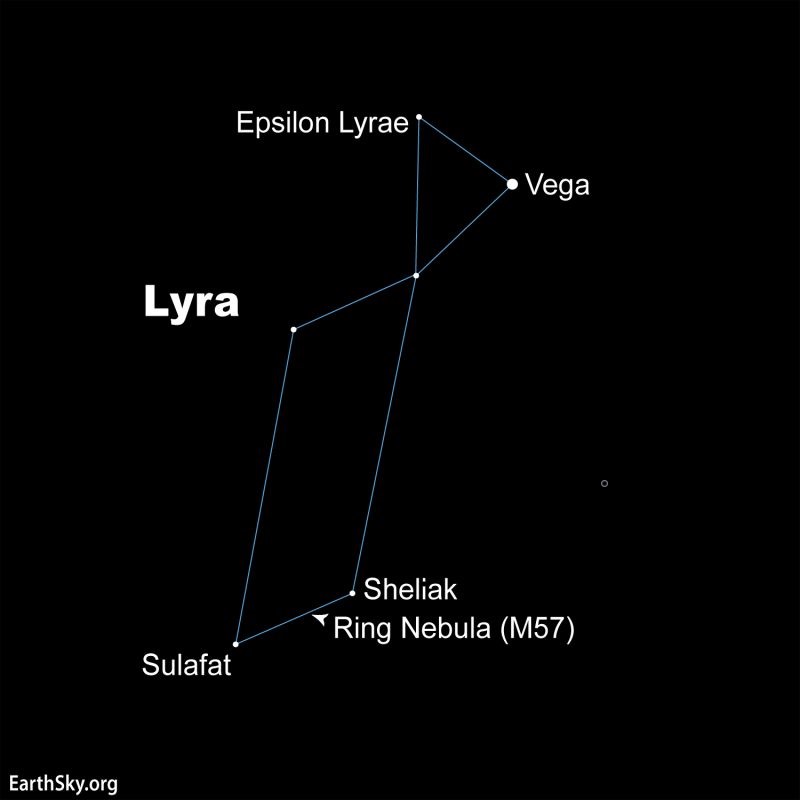
Epsilon Lyrae (ε Lyrae), also known as the Double Double star, is full of surprises. Through binoculars, what appears as one star to the unaided eye resolves into two. Through a telescope, each star in that pair resolves into two again, making four stars. And in the mid-1980s, astronomers detected a fifth star in the system. Bound together by gravity, these five stars appear as one to our unaided eyes 162 light-years away.
How to find Epsilon Lyrae
Epsilon Lyrae is wonderfully easy to find. That’s because it’s near Vega.
Vega lies in the distinctively parallelogram shaped constellation Lyra the Harp. But it’s probably more recognizable as the brightest star in the famous Summer Triangle asterism. And it’s the 5th brightest star in the sky. When you find Vega, you know that Epsilon Lyrae is near. The gap between the two only amounts to the width of your little finger with your arm outstretched towards them. Look at the chart below to see in which direction Epsilon Lyrae lies from Vega.
Although Vega and Epsilon Lyrae appear close together in the sky, they really aren’t. They simply appear that way along our line of sight. Astronomers have determined that Vega is some 25 light-years away. And Epsilon Lyrae is over six times farther, at about 162 light-years.
From mid-northern latitudes, Epsilon Lyrae and its constellation Lyra the Harp are visible for at least part of the night all year round. Epsilon Lyrae graces the night sky from dusk until dawn on summer nights in the Northern Hemisphere. It’s high overhead on northern autumn evenings. In northern winter, this star appears both in the northwest sky after dusk, and in the northeast sky before dawn. When northern spring arrives, Epsilon Lyrae rises before midnight, and shines for rest of the night.
Those at mid-southern latitudes can see Epsilon Lyrae low in the north during the Southern Hemisphere’s winter.

The Double Double star
There are many multiple star systems in the sky. But Epsilon Lyrae is special because it’s so easy to find, and so satisfying to resolve as a double star through binoculars. And in a telescope, you can enjoy viewing them as a pair of binary stars!
Epsilon Lyrae shines at +4.7 magnitude. It is just about possible to discern the widest two components of Epsilon Lyrae with the unaided eye, provided you have excellent sky conditions. But to get a clear view, you’ll want to use binoculars.
The northern star of the pair is known as Epsilon 1, while the southern star is Epsilon 2. They’re about 10,500 times the sun-Earth distance apart, and probably take hundreds of thousands of years to orbit each other.
Epsilon Lyrae’s components
Through a telescope, Epsilon 1 and Epsilon 2 reveal themselves as double stars.
Epsilon 1 has two components, designated A and B. They are about 140 times the sun-Earth distance apart, with an orbital period of about 1,800 years. Epsilon 1A is a hot star about twice the mass of the sun, while Epsilon 1B is a bit cooler, and about 1.6 times the sun’s mass.
Epsilon 2 has three components. The two components visible through a telescope are hot stars about twice the mass of the sun, separated by about 145 times the sun-Earth distance, with an orbital period of about 724 years. The third component is a star so faint that it was only detected in the 1980s by an advanced imaging technique known as speckle imaging. The difficulty of observation means that little is known about this fifth star.
Epsilon Lyrae 1 is at RA: 18h 44m 20.3s, Dec: +39° 40′ 12.4″
Epsilon Lyrae 2 is at RA: 18h 44m 22.8s, Dec: +39° 36′ 45.8″
Bottom line: Epsilon Lyrae, near Vega in the constellation Lyra, is known as the Double Double star because it appears as two stars through binoculars, and each of those resolves into two stars through a telescope.
The post Epsilon Lyrae is the famous Double Double star first appeared on EarthSky.
from EarthSky https://ift.tt/avHMFSD

Epsilon Lyrae (ε Lyrae), also known as the Double Double star, is full of surprises. Through binoculars, what appears as one star to the unaided eye resolves into two. Through a telescope, each star in that pair resolves into two again, making four stars. And in the mid-1980s, astronomers detected a fifth star in the system. Bound together by gravity, these five stars appear as one to our unaided eyes 162 light-years away.
How to find Epsilon Lyrae
Epsilon Lyrae is wonderfully easy to find. That’s because it’s near Vega.
Vega lies in the distinctively parallelogram shaped constellation Lyra the Harp. But it’s probably more recognizable as the brightest star in the famous Summer Triangle asterism. And it’s the 5th brightest star in the sky. When you find Vega, you know that Epsilon Lyrae is near. The gap between the two only amounts to the width of your little finger with your arm outstretched towards them. Look at the chart below to see in which direction Epsilon Lyrae lies from Vega.
Although Vega and Epsilon Lyrae appear close together in the sky, they really aren’t. They simply appear that way along our line of sight. Astronomers have determined that Vega is some 25 light-years away. And Epsilon Lyrae is over six times farther, at about 162 light-years.
From mid-northern latitudes, Epsilon Lyrae and its constellation Lyra the Harp are visible for at least part of the night all year round. Epsilon Lyrae graces the night sky from dusk until dawn on summer nights in the Northern Hemisphere. It’s high overhead on northern autumn evenings. In northern winter, this star appears both in the northwest sky after dusk, and in the northeast sky before dawn. When northern spring arrives, Epsilon Lyrae rises before midnight, and shines for rest of the night.
Those at mid-southern latitudes can see Epsilon Lyrae low in the north during the Southern Hemisphere’s winter.

The Double Double star
There are many multiple star systems in the sky. But Epsilon Lyrae is special because it’s so easy to find, and so satisfying to resolve as a double star through binoculars. And in a telescope, you can enjoy viewing them as a pair of binary stars!
Epsilon Lyrae shines at +4.7 magnitude. It is just about possible to discern the widest two components of Epsilon Lyrae with the unaided eye, provided you have excellent sky conditions. But to get a clear view, you’ll want to use binoculars.
The northern star of the pair is known as Epsilon 1, while the southern star is Epsilon 2. They’re about 10,500 times the sun-Earth distance apart, and probably take hundreds of thousands of years to orbit each other.
Epsilon Lyrae’s components
Through a telescope, Epsilon 1 and Epsilon 2 reveal themselves as double stars.
Epsilon 1 has two components, designated A and B. They are about 140 times the sun-Earth distance apart, with an orbital period of about 1,800 years. Epsilon 1A is a hot star about twice the mass of the sun, while Epsilon 1B is a bit cooler, and about 1.6 times the sun’s mass.
Epsilon 2 has three components. The two components visible through a telescope are hot stars about twice the mass of the sun, separated by about 145 times the sun-Earth distance, with an orbital period of about 724 years. The third component is a star so faint that it was only detected in the 1980s by an advanced imaging technique known as speckle imaging. The difficulty of observation means that little is known about this fifth star.
Epsilon Lyrae 1 is at RA: 18h 44m 20.3s, Dec: +39° 40′ 12.4″
Epsilon Lyrae 2 is at RA: 18h 44m 22.8s, Dec: +39° 36′ 45.8″
Bottom line: Epsilon Lyrae, near Vega in the constellation Lyra, is known as the Double Double star because it appears as two stars through binoculars, and each of those resolves into two stars through a telescope.
The post Epsilon Lyrae is the famous Double Double star first appeared on EarthSky.
from EarthSky https://ift.tt/avHMFSD

Aucun commentaire:
Enregistrer un commentaire